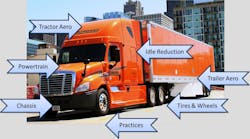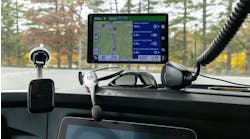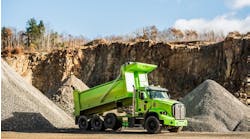Despite diesel fuel prices being in a trough last year, 17 North American fleets kept investing in a number of fuel-saving technologies for their trucks, and it's been paying off.
Compared to national average fuel costs for over-the-road Class 8 trucks in 2015, the fleets saved what would break down to about $29.5 million apiece last year, the North American Council for Freight Efficiency (NACFE) reports in its latest Fleet Fuel Study.
This is the fifth go-round of this study, with the first of its kind published in 2010. Participating fleets included Bison Transport, Cardinal Logistics, CR England, Challenger Motor Freight, Crete, Frito Lay, Maverick, NFI Industries, Nussbaum, Paper Transport, Prime, Ryder, Schneider, UPS and XPO Logistics (another two contributed data for past studies but couldn't for this 2016 report). All told, the study fleets collectively boast some 62,000 tractors and 217,000 trailers, and they saved a total of about $500.6 million in fuel costs, the study finds.
NACFE develops these annual reports along with Carbon War Room, another nonprofit that was the brainchild of Sir Richard Branson, with their combined effort known as Trucking Efficiency. The study fleets employ various combinations of 69 fuel efficiency technologies reviewed in Trucking Efficiency Confidence Reports including truck chassis, idle reduction, aerodynamic, powertrain and tractor/ trailer advancements, operational changes and more.
Last year marked the single biggest bump northward in average fuel economy the study fleets have seen — 3% — from 6.87 to 7.06 mpg. All told, that extra fuel efficiency helped the 17 fleets save a total of $500.6 million vs. national average Class 8 truck fuel spending; the national average fuel economy for those trucks was 5.83 mpg.
That's not quite the full story, though, noted Dave Schaller, industry engagement director at NACFE, since 7.06 mpg is the collective average mpg for the study fleets, which keep their trucks an average of 5 yrs. 3 mos.
"If you look at a five-year time frame, we're seeing some pretty substantial differences in fuel economy between the truck that's being traded in — say, our 2010 model year — and the new ones being operated now," Schaller said on a call with reporters Wednesday morning. "We're looking at close to a 16% gain in fuel economy between the trucks they're stepping out of and the trucks they're stepping into."
In addition, although crude oil and correlating gasoline/ diesel prices remain low or middling, Schaller pointed out that those prices are volatile and could be agitated easily. "We've just experienced, as our little planet is revolving today, two earthquakes greater than 6.0 [magnitude]. If one of those happened to hit in a fuel oil-producing area, fuel prices could change pretty rapidly — and people that didn't buy these technologies might be sorry."
Three points stood out to the 2016 study authors:
• The study fleets varied in their choices of fuel efficiency technologies.
• New greenhouse gas and fuel efficiency regulations set out a longer-term adoption of these technologies as opposed to that of the study fleets, which means fleets in general will likely need to see lower total cost of ownership/ quicker payback to make these technology investments.
• After five years of these studies, the Trucking Efficiency team noticed that trucks are being driven fewer miles. Following the Great Recession that hit hardest in 2008, fleets began upping truck productivity, hauling more tonnage with fewer loads. "This continues and even widens in 2016," according to the study.
On that last point, NACFE and Carbon War Room suggest some explanations for what's driving the productivity increase. Freight could be becoming denser/ more tightly packed; trucks could be hauling more pallets per trailer; private fleets have been reducing their empty miles; wider telematics adoption could be boosting carriers' equipment visibility and helping tighten up routing, etc.; and maybe 3PLs are getting savvier at what they do.
Can't be bothered with some tech
Mike Roeth, executive director of NACFE and operations lead for Trucking Efficiency, stressed that point in the study that the participating fleets have all gone in their own directions with technologies they put in their trucks. That goes for even similar technology such as strategies/ tech to reduce idle time, but certain technologies stood out in that particular instance. Overall, he estimated that the fleets have about a two-year ROI for their technology costs.
And although the fleets have continued to invest in fuel efficiency technologies while fuel's been cheaper, some technologies haven't fared quite as well in adoption rates as others. Essentially, Roeth surmised, those tend to be the ones that involve manual processes or require some driver inputs, like trailer boat tails the driver has to fold out.
Another example is 6x2 axle configuration on tractors, which can increase tire wear and reduce traction. "I would throw 6x2 adoption into the bucket of technology that drivers don't really like and appreciate. In a time where in 2015, tonnage was way up and it's tough finding drivers, fleets decided, 'For awhile, I'm just going to stop buying some of these technologies that require driver intervention and take that off the table when I'm trying to recruit and retain drivers,'" Roeth said.
"Some others [among less-driver-favored technologies] would be tire pressure monitoring systems, maybe some collision-avoidance systems — which really aren't in our study — or trailer tails that require drivers to do something," he added. "All those technologies require some driver interaction. They do have fuel economy benefits, but in a time when fuel prices are down, they just fall into this bucket where fleets go, 'I'll just wait, and when fuel goes up more, I'll buy these things and I'll deal with any driver education and reaction to it then.'"
A palette of fuel efficiency tech: Choose your paint
Roeth also noted on the call that a new NACFE confidence report for fuel efficiency technology due out this fall will address platooning with two tractor-trailers. A number of other technologies are listed in a Carbon War Room video, including the following.
|
• Chassis technologies: 6x2 axles; 4x2 tractors; synthetic axle lube; two-speed fan clutches; clutched water pumps • Idle reduction technologies: electronic engine controls; diesel auxiliary power unit (APU); fuel-operated/ diesel-fired heaters; battery HVAC; automatic engine start/ stop systems; AC power ports; truck stop electrification; thermal storage systems; insulation • Powertrain technologies: automated manual transmissions; automatic transmissions; downsized engines; direct-drive transmissions; synthetic transmission oil; synthetic engine oil; fuel additives; economic engine parameters; gear down protection; predictive cruise control; altered vehicle gearing; clutched air compressors • Operational practices: speed limiters; driver economy training; driver incentives; in-cab behavior notifications; routing optimization; maintenance; coasting before engine braking • Tire and rolling resistance technologies: tire pressure monitoring (tractor); tire pressure monitoring (trailer); tire pressure inflation (trailer); low rolling resistance duals; wide-based tires (tractor); wide-based tires (trailer); aluminum wheels (tractor); aluminum wheels (trailer); nitrogen-filled tires • Tractor aerodynamics: aerodynamic tractors; tractor chassis skirts; aerodynamic bumpers; aerodynamic mirrors; remove parts on tractors; roof air fairing; cab extenders; fixed fifth wheel; tractor-vented mud flaps; tractor wheel covers; tractor weight reduction • Trailer aerodynamics: trailer wheel covers; trailer-vented mud flaps; trailer skirts; undertray/ bogie fairing; trailer nose cones; vortex generators; boat tails; narrow mud flaps; double/ triple trailers; part removal/ relocation; tractor-specified weight reduction |





